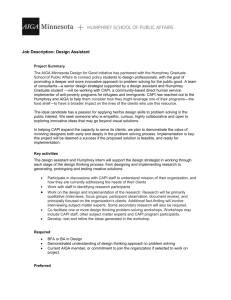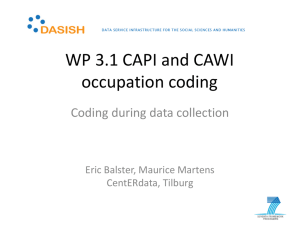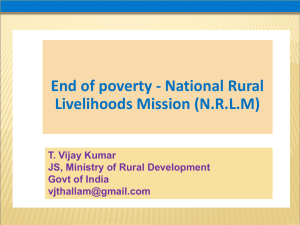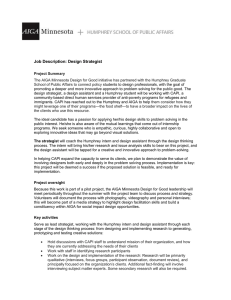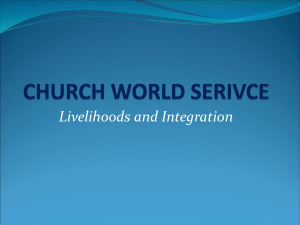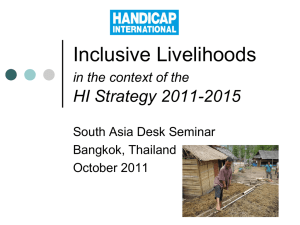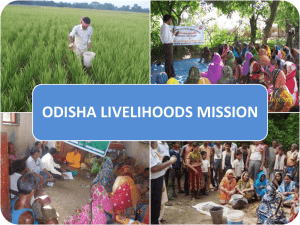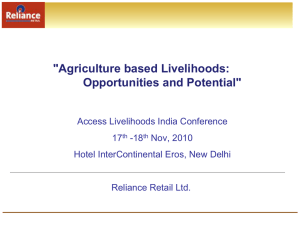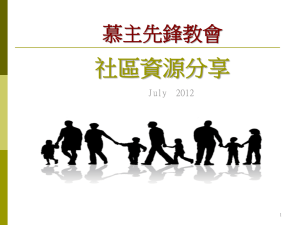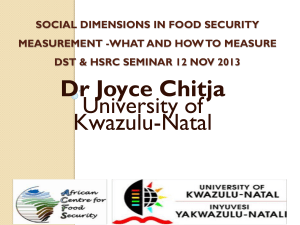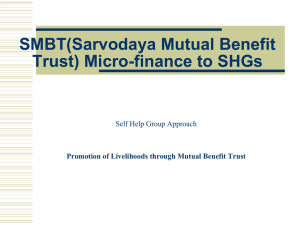Livelihoods - ACCESS Development Services
advertisement
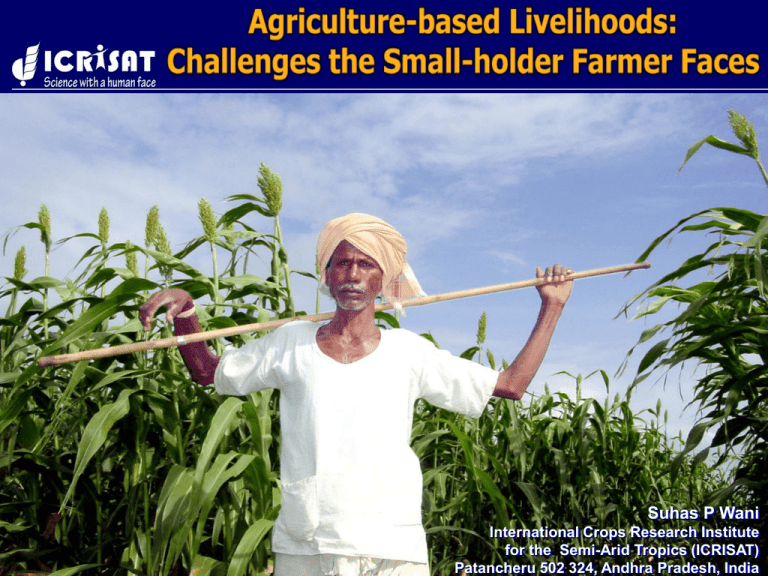
Suhas P Wani International Crops Research Institute for the Semi-Arid Tropics (ICRISAT) Patancheru 502 324, Andhra Pradesh, India Livelihoods A livelihood comprises the capabilities assets (including both material and social) and activities require for a means of living. A livelihood is sustainable when it can cope with and recover from stresses and shocks, maintain or enhance its capabilities and assets, while not undermining the natural resource-base. What we are aiming? For sustainable development To achieve poverty elimination Without sacrificing future resources Component Parts of Livelihoods Resources Livelihoods assets in Pow erguda Village Activities Fi nanc i al Capi t al 30 25 Strategies 20 15 10 Soc i al Capi t al Human Capi t al 5 0 Nat ur al Capi t al P hy s i c al Capi t al Access Institutions and organizations Social process and structures Policies, laws, social relations Current Status of Agriculture Energy and Sustainable development Health and Malnutrition-HIV Food security Water scarcity Population growth Poverty Land degradation Climate Change Number of poverty–affected people living in water-constrained, rainfed agricultural areas The three circles indicate the occurrence of global hotspots where more than 100 million people may be affected (Rockström & Karlberg, 2009). Source: Barron and Keys 2011 Agriculture-based Livelihoods More complex Spread across the geographical areas Prone to impacts of externalities – vulnerable to shocks Source: Barron and Keys 2011 Rainfed Agriculture – A Large Untapped Potential Current farmers’ yields are lower by 2 to 5 folds than the achievable yields Vast potential of rainfed agriculture needs to be harnessed 8 6 Yield (t ha-1) BW1 Carrying Capacity 21 persons ha-1 Rate of growth 82 kg ha-1 y-1 4 Carrying Capacity 4.6 persons ha-1 2 BW4C Rate of growth 23 kg ha-1 y-1 0 1976 1979 1982 1985 1988 1991 1994 Year 1997 2000 2003 2006 2009 Agriculture–based Livelihoods Agriculture–based Livelihoods Land holders Children Landless people and Livestock Women Watershed Management: Engine of Agricultural Growth and Development in Rainfed Areas Watershed as entry point for: Increasing productivity Improving livelihoods Protecting environment Empowerment of poor Social capital development Watersheds are Revolutionalising Drylands: Meta-analysis – 636 Case Studies Particulars Unit No. of studies B:C ratio Ratio 311 2.01 0.82 7.30 35.09 IRR Per cent 162 27.43 2.03 102.70 21.75 Equity Employment Person days ha-1 y-1 99 154.53 0.05 900.00 8.13 Sustainability Increase in irrigated area Per cent 93 51.55 1.28 204.00 10.94 Increase in cropping intensity Per cent 339 35.51 3.00 283.00 14.96 Runoff reduced Per cent 83 45.72 0.38 96.00 9.36 Soil loss saved t ha-1 y-1 72 1.12 0.11 2.05 47.21 Efficiency Mean Minimum Maximum t-value STEPs are holding back the potential of watershed program in India S = Sustainability T = Technology inputs E = Equity P = Participation Less than 1% watersheds are economically non-remunerative Two-thirds of watersheds’ performance can be improved Our Challenges Participation of villagers as individuals, as groups or as a whole, increasing their confidence, enabling their empowerment and their ability to plan for the future and for self-determination is needed For harnessing market potential to capture scale of economies federation of groups, villages is needed Tangible benefits to individuals for promoting quality participation are must Targeted income-generation activities for landless and women groups are needed for improving livelihoods Our Challenges Contd.. One size fits all approach did not work and it should be a tool box approach rather than straight jacketed approach It should be holistic approach for improving livelihoods thru convergence, capacity building, collective action and consortium approach Community contributions in cash/kind for construction of basic infrastructure for better participation thru demand driven interventions rather than supply driven interventions Our Challenges Contd.. Science-led development thru PR&D approach with a learning approach for researchers, development workers and investors Involvement of private sector and should be a business model approach in place of subsistence agriculture Market-led diversification of crops and sysems to achieve higher economic returns Shocks and Stresses of a Degraded Indian Watershed Management activities, which interrupt the cycle of soil degradation, and encourage system stability/ resilience Source: Barron and Keys 2011 Rehabilitated degraded CPRs thru community involvement NOVOD project: Novel initiative Capacity Building is Must for Sustainable and Increased Impact ICT has Important Role in Empowering Community Seeing is believing Community information hub Audio video training material VASAT Be Aware of Limitations Not possible to improve livelihood of everyone People like to exercise their own choices for livelihood Potential opportunities only can be shown Sustaining livelihoods involve more and separate issues from improving livelihoods Our Challenges How to maintain dynamic balance between policies and actions? How to promote sustainable livelihoods for millions of small-holder farmers? How to manage natural and physical environment in a better manner? How to build resilience of the communities and natural resources to changes in future including due to climate change Challenges to be Faced assets in Pow erguda Villageimpact How doLivelihoods we improve five capitals and assess Fi nanc i al Capi t al 30 25 20 15 Soc i al Capi t al 10 Human Capi t al 5 0 Nat ur al Capi t al P hy s i c al Capi t al Access –Institutions – Policies and Laws How to achieve following Efficiency Economic gains Equity Environment protection Thank you!
